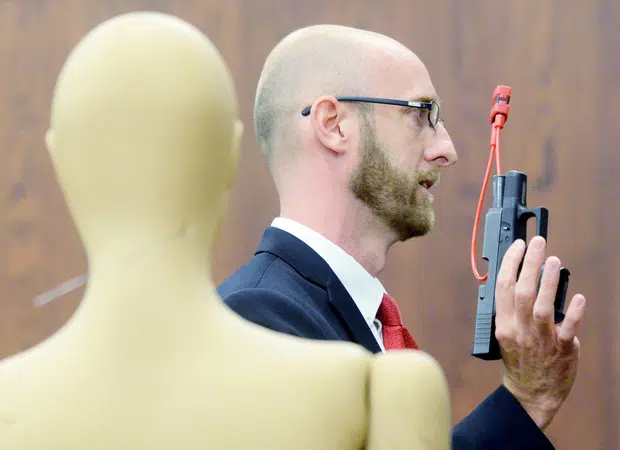Stone’s novel idea not only shut revolving door; it saved counties money, too
As the Beaufort and Jasper detention centers almost literally overflowed with defendants in the late 2000s, leaders in both counties fretted over what to do about it. On an average day, the facilities housed nearly twice as many detainees as they were designed to hold, with inmates stacked like cordwood in their cells.
Both centers were increasingly unhygienic, difficult to guard and expensive to operate. Something had to be done.
In Jasper County, the detention center director resorted to cramming a third bed into double-bunk cells. Beaufort’s director was preparing something even more radical – he would try to convince County Council to build a 1,000-bed detention center, likely to cost taxpayers more than $100 million.
But even as the detention centers brimmed over, inmates who belonged behind bars were not necessarily staying there.
To the contrary, patrol officers were often frustrated by a recurring cycle: Many offenders were arrested, only to be hauled in again for a second offense committed while out on bond for the first. The most audacious of criminals repeated the pattern more than once.
Fourteenth Circuit Solicitor Duffie Stone noticed this pattern, too, and was particularly concerned about protecting the community from the most violent of the repeat offenders. That’s when he began mulling an insight from a 19th century Italian economist that might hold a solution. Vilfredo Pareto’s observation, heeded for decades by business managers and social scientists, became an organizing principle for the Solicitor’s Office Career Criminal Unit.
This team not only helped Stone address his main concern by securing longer prison sentences for murders, rapists and burglars; it helped detention center directors and law-enforcement officers with their problems, as well.
For pennies on the dollar
At the risk of spoiling the ending, Beaufort County taxpayers never did have to cough up $100 million for a new detention center. Instead, the county provided $75,000 a year in additional funding for Stone’s Career Criminal Unit. In little more than a year, the average daily detention center population dropped from 469 to the 240s, below its capacity.
Philip Foot – at the time the detention center director and now Beaufort County’s director of emergency management – reflected on the Career Criminal Unit’s success in a 2011 documentary by the Beaufort County Channel. In it, he offered this advice: “What I’d say to other counties is, this is the way to go.”
Indeed, Jasper County followed suit, joining Beaufort and Colleton counties in funding the Career Criminal Unit. Municipalities in Bluffton, Hilton Head Island, Ridgeland and Hardeeville did the same. As in Beaufort, Jasper nearly halved its average daily detention center population, all the way down to 70 inmates per day, Director Arthur S. Benjamin Jr. reported in the 2011 documentary.
Stone was achieving his goal, too. The Solicitor’s Office docket fell from 3,158 pending cases in 2009 to 1,473 by the end of 2012.
The Career Criminal Unit’s impact was not only immediate; it has proven long-lasting.
Through mid-2022, the team had secured convictions against 416of the 448 defendants it prosecuted – an astounding rate of 92.9% against the circuit’s most dangerous criminals.
The career-criminal concept also helped drive another remarkable trend: Between fiscal year 2010 and fiscal year 2021, the number of new arrest warrants issued dropped nearly 11% in the 14th Circuit, even as its population rose 9.2%, according to S.C. State Law Enforcement Division statistics.
Of South Carolina’s 16 circuits, only one other saw a drop in criminal offenses while gaining new residents.
“That is just incredible to me because those numbers almost always rise and fall in tandem,” Stone said. “And we didn’t merely experience a decline in arrest rates; we saw a straight-up decline in total arrests, during a period of population growth.”
While it is difficult to determine how much of this improvement is directly attributable to the Career Criminal Unit, it is safe to say its effect has been widely acknowledged and widely felt.
“Few things are more frustrating to a cop than arresting the same people over and over,” said Solicitor’s Office Investigator Derek Nelson, who once was a patrol officer for the City of Charleston and the Beaufort County Sheriff’s Office. “I don’t think the public likes it or understands why it happens, either.
“The Career Criminal Unit sent a signal that bad guys weren’t just going to be run through the system again and again. Offenders are still entitled to bond and still get released, but now someone is paying attention, particularly to the criminals who pose the biggest threat.”
(STORY CONTINUES AFTER GRAPHIC)
The secret to the success
The unit’s success raises a question: Why has the career-criminal approach worked so well?
The answer harkens to that 19th century Italian economist, Vilfredo Pareto.
In a 1896 treatise, Pareto noted that 80 percent of the land in Italy was owned by 20 percent of the population. Subsequent scholars realized the Pareto Principle – also known as the 80/20 Rule or the Law of the Vital Few – applies in many different fields. In your garden, 80% of your tomato harvest often comes from just 20% of your tomato plants. In industry, the top 20% of your firm’s sales force typically produces 80% of its sales.
The principle applies to criminals, too.
In 2008, Stone examined his General Sessions Court docket and realized about 80 percent of the offenses in his circuit were committed by about 20 percent of the offenders, just as Pareto might have predicted. He also realized the detention centers weren’t overwhelmed by offenders who were arrested once and parked there. Rather, the excess was caused by inmates who had been released on bail but arrested again for new crimes before they could be prosecuted for their old ones.
Lowering bonds or even setting inmates free after a night or two in jail would not likely ease detention center overcrowding. It certainly wouldn’t make the public safer, either, Stone concluded.
He formed the Career Criminal Unit with a smarter goal in mind: Get repeat offenders out of the community and into state prison as quickly and for as long as possible.
Stone made a few other relevant observations, subsequently confirmed in a 2011 University of South Carolina analysis of crime in Allendale County: First, career criminals seldom restrict their activity to a single law enforcement jurisdiction. They will commit crimes wherever the urge or opportunity arise. Second, they seldom specialize in a specific type of crime.
“What most people call a crime problem is really a problem with a particular set of criminals,” Stone said.
Moreover, a mid-level drug dealer who lives in Bluffton might support his own habit by burglarizing homes on Hilton Head Island and protect his turf by assaulting a rival dealer in Ridgeland.
Stone devised a solution quite unlike the criminal-justice and law-enforcement initiatives prevalent at the time. Three-strikes laws, the war on drugs, special gun laws – these put the focus on the crime committed, rather than on the criminals committing them.
The Career Criminal Unit would shift the focus by:
- Gathering as much information as possible about all defendants as soon as they are arrested, so that career criminals can be identified;
- Arguing forcefully for high bonds for career criminals and for bond revocations for any career criminal rearrested while awaiting trial;
- Seeking substantial sentences – often the maximum allowed by law – and refusing to offer lesser sentencing recommendations in exchange for guilty pleas;
- Developing top-notch trial attorneys for the Career Criminal Unit, since this hard line on plea negotiations would prompt many defendants to take their chances with a jury;
- Reducing those attorneys’ caseloads so that they have sufficient time to prepare the team’s complex cases.
A test case
In late 2008, Stone decided he would reorganize his office to create a Career Criminal Unit. However, the first test case came along before he had formally assembled the team.
That September, the Jasper County Sheriff’s Office arrested Eloise Simmons on a domestic violence charge. Though she had never done any serious time in prison, the arrest was Simmons’ 31st in South Carolina. She posted bond on a Tuesday, and by that Thursday, she had racked up her 32nd arrest by slicing her husband with a pair of garden shears.
Enough was enough.
When Stone learned details of Simmons’ rap sheet and her latest arrest, he assigned the case to an attorney he was considering for a role on the Career Criminal team.
“I asked Meredith Bannon to pick up the file, meet with the victim and get the case to trial as soon as possible,” Stone recalled.
Within five weeks, Bannon had Simmons in front of a circuit court judge for a guilty plea. Facing a maximum of 10 years for her most recent offense, Simmons was sentenced to eight years in prison, the longest penalty she had ever faced.
Emboldened, Stone pressed ahead with his plans. Believing the Career Criminal Unit could make the circuit safer and reduce detention center populations at the same time, he convinced three of his five circuit counties to provide funding for the new team. A year later, he secured a federal grant to expand the program into the circuit’s two most poverty-stricken counties, as well.
On Jan. 13, 2009, the first two career-criminal defendants entered guilty pleas in Colleton County General Sessions Court. Samuel Johnson received 20 years for first-degree burglary, armed robbery and kidnapping. Ricardo Hall was sentenced to 10 years for armed robbery and second-degree burglary. Deputy Solicitor Sean Thornton prosecuted both cases.
By the end of the year, the Career Criminal Unit had prosecuted 31 defendants and secured convictions against 29 of them. Nine were convicted in jury trials. The guilty were responsible for a total of 64 separate charges.
(STORY CONTINUES AFTER SLIDESHOW)
Continued success
Most of the original precepts have endured, but the Career Criminal Unit has evolved through the years, too.
For instance, today’s career criminal cases seldom come to disposition as quickly as Eloise Simmons’ did back in 2008. Many entail legal complexities and forensic evidence that takes time to process, making such quick turnaround impractical or even dangerous.
“We still prosecute career criminal cases with urgency, but we’ve learned that getting the appropriate outcome depends far more on being thorough and well-prepared than operating at break-neck speed,” Stone said.
The Solicitor’s Office employed investigators before the Career Criminal Unit was formed, but focusing on the criminal rather than the crime required a full-fledged Intelligence Unit, as well.
The Pareto Principle still applies, but the office has made a few adjustments in the name of practicality.
“Early on, we were assigning every defendant with a long rap sheet to the Career Criminal Unit,” Stone said. “This approach produced more cases than our team could handle. We also realized that if we stuck too strictly to the original rules, our less-experienced attorneys would be the ones left to prosecute every murder and sexual assault committed by a first-time offender.
“So, we refined things, and we continue to refine. Today, instead of focusing on 20% of offenders, we focus on the worst 10%, in addition to anyone charged with crimes with the potential to bring sentences of 20 years or more.”
Careful allocation of resources has been a key to sustaining the Career Criminal Unit. The number of team members has expanded to include dedicated investigators, intelligence analysts and victim advocates. However, it has occasionally contracted, too, when funding waned.
Nonetheless, when the federal grant that brought the program to Hampton and Allendale counties expired, Stone found a way to use increased appropriations from the General Assembly to keep the team afloat there.
Maintaining a stable of skilled attorneys has been perhaps the greatest challenge, Stone said.
Attorneys who excel at trial are crucial because so many career criminal cases are argued in front of a jury. To put their work in context, consider that over the past decade in South Carolina only 0.4% of all General Sessions charges have been disposed of with a trial. Fewer than 0.8% of convictions are the result of jury verdicts.
By way of comparison, 35% of Career Criminal defendants have been tried before a jury.
“The credibility of the team depends upon our ability to win jury trials,” Stone said. “In the early days, we scrambled to put together a career criminal staff because a lot of our attorneys were not all that experienced. Then, once we had developed some really good attorneys, the challenge was retaining them because, historically, the pay wasn’t very good.
“It’s taken a lot of training and planning, but after more than a decade, we’re to the point where we can offer a pay structure commensurate with their skill and experience.”
Entering 2022, 24 different attorneys had handled career criminal cases at some point, but only seven had prosecuted 10 or more defendants. Of those, six were still employed by the office.
Among them are Hunter Swanson, who has racked up more victories than any other team member. She, Thornton and Stone have prosecuted cases for the unit since the beginning.
“This team has done a lot of good and helped the community deal with people who can’t conform to society’s norms,” Swanson said. “As a prosecutor, I think you’re either crushed or energized by this work. There is a lot riding on your cases. We’re prosecuting the worst of the worst. You know you’re usually seeking maximum sentences, and you know you’re probably going to trial.
“That can be a lot of pressure, but (Solicitor Stone) has done a good job of giving us the resources to do this well.”
That commitment was an easy decision for Stone.
“In my years as solicitor, developing the Career Criminal Unit is probably the most unambiguously successful and impactful program our office has developed,” Stone said. “There is no doubt in my mind the 14th Circuit is a safer place because of this team.”




